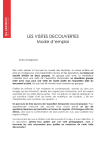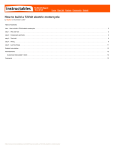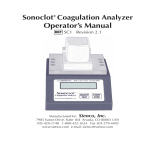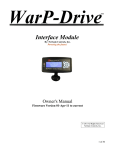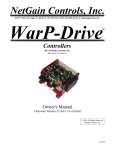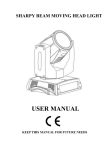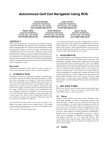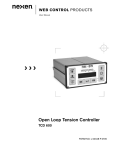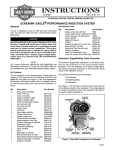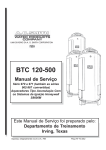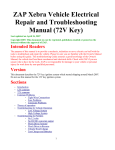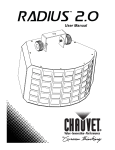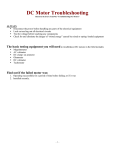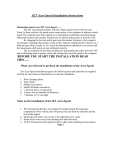Download Owner`s Manual - NetGain Motors, Inc.
Transcript
Owner's Manual Please record your motor serial number and date of purchase on this page. Motor Serial Number: _________________________________________ Date of Purchase:_____________________________________________ Purchased From:______________________________________________ Motor Model: AMD 8” Other September 16, 2008 RE: Your new NetGain Motors, Inc. Motor It is with great pleasure that we at NetGain Motors, Inc . welcome you to the WarP Motors TM owner's family! We would also like to “Thank You” for your purchase. Since electric motors are different from internal combustion engines, this Owner's Manual is being sent to you to provide information on running and caring for your new motor. Please read it carefully and follow the suggestions that will provide for years of great performance from your new motor. This Owner's Manual contains the new motor warranty, our dealer's safety information sheet, wiring tips bulletin, heat and rpm protection bulletin, care and maintenance information sheet, bench test procedure bulletin and other information of interest and importance. There is also a substantial amount of content that may be obtained at our website: http://www.goev.com Along with your dealer, we definitely want to help make your EV project a success, so please let us know if you have any questions about your motor, safety, wiring or anything else. We'll help you or find resources that can help. Again, we thank you for your motor purchase – we wish you success in your EV project! WarP Motors TM – TORQUE ABOUT IT! George Hamstra NetGain Motors, Inc. President WarP Motors TM NEW MOTOR WARRANTY* WARFIELD ELECTRIC COMPANY, INC. (The Company), warrants that new motors sold by it are merchantable and free of defects in material and workmanship at the time that they are shipped from the company’s factory. The company makes no warranty with respect to the new motors other than the warranty stated above. All implied warranties of merchantability and all express and implied warranties of any other kind are hereby excluded. The company will repair or, at its option, replace any part of any new motor sold by it that fails to conform to the warranty stated above, provided Warfield Electric Company, Inc. (factory) is contacted for a Repair Authorization Number (RA#) and such part is returned to the company’s factory or to a factory authorized service station, transportation charges prepaid, within the warranty period specified below: NEW MOTOR WARRANTY extends for a period of one year or 2000 hours of equipment operation, whichever first occurs, following the date of delivery of such equipment into which the motor has been installed, but warranty coverage will not exceed a period of two years from the date the motor was shipped from the company’s factory. Proof of equipment installation date and equipment hour meter reading must be provided. LIMITATION OF LIABILITY The company’s liability, whether in contract or in tort or under any other legal theory, arising out of warranties, representations, instruction or warnings (or any lack or inadequacy thereof), deficiencies, failures or defects of any kind or from any cause shall be limited exclusively to repairing or replacing parts (during normal business hours) under the provisions stated above. All liability for damages, including, but not limited to, those expenses, or injury to business credit, reputation or financial standing is hereby excluded. The warranties contained therein shall not apply to or include any of the following and the company shall have no liability with respect to: 1. Repair or replacement required as a result of: (A) accident; (B) misuse or neglect; (C) lack of reasonable and proper maintenance; (D) operation in excess of recommended capacities; (E) repairs improperly performed or replacements improperly installed; (F) use of replacement parts or accessories not conforming to Warfield Electric Company, Inc. specifications which adversely affect performance or durability; (G) alterations or modifications not recommended or approved in writing by Warfield Electric Co., Inc. and (H) wear and deterioration of motor appearance due to normal use or exposure. 2. Normal replacement of consumable service items, such as brushes and brush springs. 3. Motors in equipment whose ownership has been transferred from the first purchaser for use to another. * No agent of Warfield Electric Company, Inc. is permitted or authorized to change, modify, or amend any term of this warranty. WarP Motors TM Safety Information This is not an all inclusive list. Use common sense and act responsibly, electric motors are extremely powerful and could cause death, dismemberment or other serious injury if misused or not safely handled! Use caution when operating any motor. If you're not sure what you're doing, find a knowledgeable person to advise you! Remove all metal jewelry and metal objects from hands, wrist, fingers, etc. before working on any electric motor. If working on an electric vehicle, make certain the vehicle is positioned securely with the drive wheels safely clear of the floor and blocked up so that the drive wheels cannot make contact with the floor under any circumstances. Block the non-drive wheels if they remain in contact with the floor so that the vehicle cannot roll in either direction. Before troubleshooting or working on any electric vehicle, disconnect the battery and discharge all capacitors. Reconnect the battery only as needed for specific checks or tests. Motors must only be connected to a power source by knowledgeable and experienced personnel. Motors should NEVER be run without a load. Running a motor without a load could result in harm to people or the motor. Absence of a load is considered misuse and could prove dangerous to anyone in the vicinity and void the motor warranty. Portions of the motor may become hot and proper precautions must be taken. Motors are heavy and are likely to become damaged if dropped, or cause damage to anything they fall upon (including people and body parts). Use extreme caution when working with motors! Make certain the motor is disconnected from any power source before servicing. Motors contain moving parts that could cause severe injury if the proper precautions are not taken. Never touch an operating motor. Motors should never be operated beyond the limits established by the manufacturer. Motors must not be modified in any manner; doing so will void the motor warranty and could prove extremely dangerous. Wear protective or safety equipment such as safety shoes, safety glasses and gloves when working with motors. Make sure you know where the closest functioning eye wash station is before working on or testing batteries. Do not defeat any safety circuits or safety devices. Under no circumstances should you push in any contactor of an electric vehicle while the drive wheels are in contact with the floor. Pushing in a contactor when the drive wheels are in contact with the floor can cause serious property damage, personal injury or death. WarP Motors TM Information NetGain Motors, Inc's. WarP Motors TM are produced by Warfield Electric Company in Frankfort, Illinois, USA. Warfield is the nation's largest rebuilder of series wound DC motors. Matching their experience and knowledge with our engineering and racing experiences, makes a perfect team to design motors that will perform under the unusual operational dynamics of electric vehicles. All aspects of an electric motor were considered - from the components to the methodology of assembly - to make a motor that would perform in an electric vehicle. Electric motors components are very critical in an electric vehicle, as are voltage and amperage, range, bearings, shaft sizing, commutator and brush coordination, windings and temperature range. Assembly steps critical to performance are clearances, brush “break-in”, lacquering/baking process and overall quality of workmanship. One area of serious study has been temperature. Where most DC motors are made to meet class F temperature rating (155º C.), our WarP Motors TM all exceed class H ratings (180º C.) (Our WarP Motors TM have been stress tested to 205º C). Whether using your DC motor for drag racing or for an everyday EV, temperatures will normally never approach 180º C. However, an external high volume fan or blower can be very effective in further dissipating motor heat, and additionally clears carbon dust from the brushes, which reduces risk of flash-over and would-be damage. WarP Motors TM are designed with an internal fan to provide cooling and motor protection during normal operation. All WarP Motors TM are also configured with a temperature snap switch as a standard item (normally closed) for early warning of an overheating situation. The snap switch is set to open at 120º C (150º C for 11" & 13" motors) and can drive an indicator light or warning tone in your vehicle or automatically open a circuit in your vehicle if it indicates overheating. Motor ratings are given for the normal range of the motor's operation under various voltages and loads. Ratings with forced cooling have not been done since there are too many variables that cannot be controlled to allow the data to be useful. Needless to say, the motor will perform closest to its initial HP output the cooler one can keep it! Some larger DC motors have interpoles. Because of the compactness of most motors 9” or less in diameter, in these horsepower ratings, interpoles cannot fit inside. Our WarP 13 TM and WarP 11 TM motors can have interpoles added, but they are not the standard configuration. Lastly, please remember that WarP Motors TM offer distinctive standard features on every motor that we feel make it the best choice for an electric vehicle motor in the industry. Some of these features are: Standard WarP Motors TM Features ✔ Specifically designed for street and racing EVs ✔ Top quality, sealed, steel bearings with high temperature grease ✔ Motor temperature snap switch ✔ Brush Wear Indicators (eff. 4/2007) ✔ High efficiency fan ✔ Optimized brush timing ✔ Oversize brushes ✔ High quality brushes- not “quick-seat” ✔ Fully 90% plus brush wear-in1 ✔ Heavy duty, vibration resistant, stainless steel brush springs ✔ Pre-drilled advanced timing holes for higher performance ✔ Insulation that exceeds Class “H” temperature rating ✔ Best in class patented varnishing process ✔ Voltage ranges starting at 48 Volts ✔ Interlocking commutator construction ✔ High peak motor efficiency ✔ Dynamically balanced armatures ✔ Hand made in the U.S.A. by experts 1 The brush wear-in process is completed before the brushes are placed into the enclosure so that no carbon dust is allowed into the motor. Date: April 13, 2005 To: All WarP Motors TM Dealers Subject: WarP Motors TM Wiring (except WarP 13 TM ) Several sources have recently inquired as to what the proper method was for wiring the terminal lugs on the cases of WarP Motors TM . This Special Update clarifies the proper wiring method. All WarP Motors TM cases have four terminals,A1, A2, S1, S2 stamped on the case at the factory. Motors are designed to normally operate in Counter Clock Wise rotation at the Drive End (CCWDE )for forward vehicle operation. When a motor is specified as “advanced timing”, it is assumed to be relative to the normal CCWDE rotation. Motors that do not have advanced CCWDE timing may be wired for Clock Wise rotation at the Drive End (CWDE ). These instructions should help clarify the proper wiring method for both rotations. WarP Motors TM (except the WarP 13 TM ) should ALL be jumpered according to these instructions (battery polarity does not matter): For CCWDE rotation wire as follows:* CCWDE preferred connection method: Connect A1 to S1 Connect A2 to one input power terminal and S2 to the other input power terminal CCWDE alternative connection method: Connect A2 to S2 Connect A1 to one input power terminal and S1 to the other input power terminal For CWDE rotation wire as follows: CWDE connection method: Connect A1 to S2 Connect A2 to one input power terminal and S1 to the other input power terminal C W D E alternative connection method: Connect A2 to S1 Connect A1 to one input power terminal and S2 to the other input power terminal Motors that have “advanced timing ” for CCWDE rotation should not be run in CWDE mode. Doing so may damage the motor and void the warranty. *Dealers may request a motor be timed advanced for CWDE operation by specifying this on their Purchase Order. This will be considered a “Special Order ” and may involve an additional cost. Date: October 24, 2006 To: All WarP Motors TM Dealers Subject: TransWarP 11 TM Motor Wiring and errata* Normal wiring for Counter Clockwise Rotation when viewed from the Drive End (CCWDE) of a WarP ImPulse TM or TransWarP 9 TM Motor is: A1-S1 or A2-S2. However, on the TransWarP 11 these motors is A1-S1 or A2-S2. TM TM , the wiring for CCWDE is: A1-S2 or A2-S1. For CWDE the wiring on Additionally, all of the NetGain Motors, Inc.. 11-inch and 13-inch motors incorporate a 150° C snap switch. Other motors utilize a 120° C snap switch. Wiring information for other WarP Motors TM may be found in the Special Updates dated 04/13/2005 and 03/01/2006. You may locate copies of these and all other Special Updates on our Web Site at: http://www.go-ev.com/dealers-only/Dealer_Manual All motors produced in 2007 will incorporate 2 lifting holes to aid installation. These holes will be positioned 90 degrees apart in order to allow better positioning of the terminal studs. Broken fins, which occasionally occurred on ImPulse 9 and WarP 9 motors due to the placement of advanced timing holes, will now be machined during assembly. Dealer input is always welcomed, if you have any suggestions on how we might improve our motors, please contact us! 04/13/2005 and 003/01/2006. You may locate copies of these and all other Special Updates on our Web Site at: http://www.go-ev.com/dealers-only/Dealer_Manual * Beginning in 2008, all new TransWarP 11 Motors TM will be produced so they are wired identical to all other WarP Motors If you purchased your motor prior to 2008 you should verify correct rotation prior to installation! TM . Date: February 13, 2006 To: All WarP Motors TM Dealers Subject:WarP Motors TM Heat and RPM Protection Bulletin Throughout the year we have had inquiries about the effects of heat and RPM's on WarP Motors TM. This Special Update summarizes many of our conversations with individual dealers and shares the same knowledge across our entire dealership network. As in our other Special Updates , this information does not cover every aspect of the motor's usage. If you have a situation that you are unsure about, please call someone that has the expertise or seek more detailed information. Please act responsibly and protect yourself and your customer from personal harm or damage to the motor. Motor Heat 1. All WarP Motors TM are rated over Class H, which is 180 degrees C, but one still needs to protect the motor from overheating 2. If you are using your motor for drag racing, with 10-20 seconds of high load, the brushes and comm will heat up faster than the other parts of the motor. To protect your motor in this case, measure temperature in the brushes and the comm surface area using an infrared device that can react quickly. Heat can build very fast, as you would expect and may already know! 3. If your motor is used for normal vehicle travel, the ends of the pole shoes and the motor case by the shoe bolts will generally be the area of greatest heat build up. To protect your motor in this area, the normal temperature snap switch is installed. Connect it to give the driver a warning light or to automatically open the circuit if it indicates overheating. Heating will build slower here, but fast action needs to be taken to protect the system. 4. Consider setting a temperature of 110-120 degrees C for your action starting point as a safe way to manage a potential overheating situation. 5. Lastly, always ensure that sufficient and proper air circulation through the motor is not impaired! Motor RPM 1. All WarP Motors TM have commutators that were tested to over 8,000 RPM, but that does not mean they can be run at that speed indefinitely! 2. Most motor comutators built now are composite. Steel commutators were used in the past, but are now made for custom orders and very expensive. Steel core commutators are generally able to withstand higher RPM speeds. 3. We like to recommend safe speed ranges from 2000- 3500 RPM, even though we know some of our WarP Motors TM are peaked around 5,000 RPM for small intervals of time. When working with a customer, please be sure to design gearing so that the customer gets the speed he wants, but the motor will not be at a high RPM for long periods of time. 4. Lastly, utilize one of the many ways available to protect the motor from exceeding 8,000 RPM and make sure it is installed and working properly. It just needs to work once to pay for itself, save the motor and protect all the people around the vehicle! Date: February 15, 2006 To: All WarP Motors TM Dealers Subject:WarP Motors TM Care and Maintenance This Special Update summarizes many responses we have given to dealers and customers alike about motor care and maintenance. As the sphere of users continues to grow for electric motors used in vehicles, knowledge about motors needs to be communicated to all those users across our entire dealership network. As in our other Special Updates , this information does not cover every aspect of the subject. Here are a few simple steps one should take to make the WarP Motors TM give years of great performance. 1. Protection from the elements is important. Utilize good design concepts and materials to protect the motor from rain, snow and ice. 2. Design the motor mounting area to allow for good air flow. The motor needs a continuous supply of clean fresh air to cool properly. 3. Protect the motor from “dirty air” that may be used to cool it. Most airborne grit will act as an abrasive, which will eventually cause harm to the internal parts of your motor. 4. Clean the brushes and comm area regularly from the dust/dirt that occurs during normal operation. 5. Regularly check connections, voltages, tolerances and alignment to assure they are within normal specifications. 6. If you suspect or question the motor's operation, immediately shut it down. Record any visual signs, audio sounds or scents at the time and ask an expert for an opinion prior to operating the motor again. 7. Always operate the motor within the normal safety ranges for voltage, amperage and RPM 8. Follow all the safety rules available to you. 9. Remember your motor will take care of you, if you take care of it. Series Motor Bench Test Procedure (Test at 12 volts ONLY) CAUTION! Read completely! Power source Heavy Duty Charger + Caution!!!! Y Sparks can ignite gases emitted from batteries! Use quick-connect cables for battery and motor! DO NOT HARDWIRE MOTOR AND CONNECTIONS! Make certain that the motor is securely strapped or bolted in position. The motor must not be allowed to 3 < 12 volt . . . 20 feet . . . Y- 2 A1 S1 A2 S2 BATTERY > move! 1 If a battery is used instead of a charger, the battery must be at least 20 feet away from the motor in a well ventilated area or preferably outside of the building! The cables MUST be connected and disconnected in the order shown! Connecting sequence: 1. Connect cable #1 and cable #2 first. 2. Connect cable #3, to power source positive terminal (+) at the power source first, NOT at the motor. 3. Connect the other end of cable #3 to terminal (A1) at the motor which is 20 feet away from the power source. Disconnecting sequence: 1. Disconnect cable #1 first. (This deactivates the motor) 2. Disconnect cable #2 and then #3 from the power source. Last updated: June 23, 2008 Welcome to the NetGain Motors, Inc. Frequently Asked Questions (FAQ). This document will attempt to answer many of the questions that we are asked related to our products. 1. Where did the WarP name come from? We are not “trekkies”, but we do enjoy Star Trek. However, that had very little to do with the original name selection for our motors. The name was a natural way of differentiating our motor series, and also showed that we intended on incorporating new and advanced thinking in the enhanced designs of the motors we planned on building. The “War” portion of the name comes from Warfield Electric Motor Company. Jerry Warfield was instrumental in our original designs (and subsequent designs, as were John Wayland and numerous others...). The capital “P” at the end of the name is also significant. It stands for “Phil Brown”, a close friend and supporter of our original electric dragster concept vehicle. Unfortunately, Phil was taken by cancer prior to the project gaining momentum. We intend to maintain this method of honoring Phil in the naming of our ImPulse, and TransWarP motors as well. As the ImPulse motors are the least powerful of our motors and the TransWarP motors utilized a transmission style armature shaft, the TV series names were a natural fit and also allowed us to use the capital “P”. 2. Which WarP Motor, ImPulse Motor or TransWarP Motor should I use? The answer to this question depends upon MANY factors! We would be happy to discuss which motor we feel meets your needs the best, and to run your requirements through our motor selection software. The first question you should ask is: What is the intended purpose of the vehicle? Will it be used as a “daily driver”? Will it be used strictly for racing? Will it be a performance vehicle, or will it be designed for greatest range between charges? In addition to knowing the answers to these questions, you should have some realistic thoughts relating to: 1. 2. 3. 4. 5. 6. 7. 8. 9. Top speed to be maintained ______________________ Percent grade the vehicle will travel on ______________________ Wind resistance (frontal area) of the vehicle ______________________ Total vehicle weight (with driver/passengers/load) ______________________ Final gear ratio ______________________ Tire Diameter ______________________ Voltage to be supplied to the motor ______________________ Coefficient of drag ______________________ Battery internal resistance ______________________ 3. How do I become a dealer of WarP Motors ? You should visit our Web Page (http://www.go-ev.com) and print a copy of the Dealer Application. Fill out the form completely and FAX it back to us. You must have a valid existing business with state resale sales tax numbers in order to even begin the process. We also consider proximity to other Dealers, experience converting vehicles to electric, and other factors, web only Dealers will no longer be considered. 4. What is an ICE, what is an EV, Hybrid? ICE stands for Internal Combustion Engine. EV stands for Electric Vehicle. A hybrid vehicle is one that uses a mixture or combination of technologies to propel the vehicle. Hybrids are generally one of two types: series or parallel. A parallel hybrid uses multiple, possibly combined, means of powering the vehicle, while a series hybrid generally uses a source to produce electricity in order to power an electric motor that actually drives the vehicle. 5. What do the abbreviations "DE" and "CE" stand for? "DE" stands for "Drive End". This is the end of the motor that usually contains the fan and usually has a larger diameter shaft. "CE" stands for "Commutator End". This is the end of the motor where the brushes and commutator are. Motors that are specified as "no CE shaft" do not have a shaft extending from this end. "CE" is also the abbreviation used by Dennis Berube for his world record holding electric dragster: Current Eliminator. 6. What do the abbreviations "CCW" and "CW" mean? "CW" stands for "ClockWise" rotation and "CCW" stands for "Counter-ClockWise" rotation. These abbreviations are normally used in conjunction with "DE" and "CE" to indicate the perspective of the armature rotation. For instance: "CCWDE" would indicate Counter-ClockWise rotation when viewed from the Drive End – this is the default for all WarP Motors with the exception of the TransWarP 7 which is neutrally timed from the factory (but may be ordered with advanced timing. CWDE would indicate "ClockWise rotation when viewed from the Drive End. Most vehicles require CCWDE, however, some vehicles (i.e. Honda transmissions) may require CWDE. You should verify the rotation prior to ordering as the timing can be requested to be advanced timed for the rotation of the motor. 7. What is "Timing" on an an electric motor? Timing an electric motor refers to the position of the brushes on the commutator. Normally, brushes are fixed into a position on the commutator during the manufacturing process. The position they are normally set at from a manufacturer is a "neutral" position. A "neutral" position allows the motor to operate and perform almost identically in CCWDE and CWDE rotations at normal voltages. A normal voltage for most series wound motors in a neutral timed arrangement is generally less than 96 volts. Above this voltage motors should almost always be advanced in the direction of their normal rotation in order to reduce arcing, improve RPMs, and to provide increased performance at higher voltages. CAUTION: If a motor is advance timed and then powered to run in the opposite direction of the advancement, significant arcing damage and could result if high power is applied! Regen should not be attempted with motors that been advance timed! 8. How do I know how much to advance the timing on a motor? All new WarP Motors have pre-drilled holes that allow the commutator end-bell to be removed and the brushes repositioned in a neutral, or an advanced position, either CWDE or CCWDE. The WarP, ImPulse, and TransWarP Motors are each advanced ~12 degrees. The WarP 8 motor is advanced ~10 degrees. The amount of advancement is based upon the width of the brushes, the number of commutator bars, the diameter of the commutator and various other factors that are monitored when the motor is run on a dynomometer. The proper terminology used to describe an advanced timed motor would be "advanced timed, CCWDE" or "advanced timed CWDE". The term "retarded" that is often used to describe the timing of ICE (Internal Combustion Engine) vehicles is not applicable to electric motors. You may simply loosen 4 bolts and rotate the bell housing in the direction you desire to advance the timing from the neutral position. All of our motor cases are stamped with “CW” “N” and “CCW” - you can determine the advance state by seeing which commutator end bell bolt is aligned with the letters stamped in the case. NOTE: The WarP 8 motor has been replaced in our product line by the introduction of the ImPulse 9, ImPulse 8, and AMD 8” motor. 9. How can I order WarP Motors? WarP Motors may only be ordered through an Authorized Dealer. A list of Dealers is available on our web page at http://www.go-ev.com 10. What if I need something other than the "standard" motor? NetGain Motors, Inc. will work with our motor manufacturer – Warfield Electric in order to ascertain your specific needs and develop a motor to meet your needs. Custom motor options, such as special materials, components, shaft splining, special composition brushes, or other variances from standard configurations are available at an additional cost. Contact NetGain Motors, Inc. with your needs and we will provide a quote. 11. Where can I get replacement parts for my motor. Replacement parts and components can be ordered through any Authorized Dealer. 12. Can I put an alternator or generator or windmill or solar panels on my vehicle to keep the battery charged? In brief: "NO"! We receive this question on almost a daily basis! If you figure out a method of actually getting more energy out of something than you put into it – please let us know immediately! To date, no one has figured out how to accomplish this feat – and though you aren't going to receive a ticket for trying, there are certain laws that you would be in violation of. Though windmills and solar cells may certainly be used to help charge batteries, most of the motors we sell are for use in vehicles that can draw between 340,000 watts (for a short time), and 15,000+ watts at highway speeds. If you have the time and plenty of sunlight and wind, these resources could certainly replace at least some of the energy consumed – just not as fast as people generally use it, or as quickly as you may want. 13. Can I use your motors in marine applications? Certainly, but don't submerge them, and protect them from saltwater. Also, pay particular attention to #12, above. It is extremely difficult to create a watercraft with 10-12 hours worth of wide-open power with todays generally available battery technology. 14. What are the two wires that come out of the motor case and how do I use them? These wires are connected to a normally closed 120C thermal switch. On 11” and 13” diameter motors a 150C thermal switch is used. This switch is used to determine whether a motor is nearing a temperature that could cause internal damage to the motor. Some people refer to this switch as a “nuisance switch”. We do not suggest that this switch be used to automatically disable the motor if a heat condition arises as circumstances may require driving the vehicle to a safe area before shutting down. Some people use this switch to keep a contactor open by applying 12-volts to the switch. If the voltage is dropped (by the switch opening), then a light could be lit, or a buzzer sounded to indicate a potential problem exists. 15. What is the round black connector on the commutator end bell used for? Recent modifications have been made to all the WarP Motors, TransWarP Motors, and ImPulse 9 Motors to add a brush wear indicator. If you look carefully into the connector you will see that the round black connector actually accepts flat, female, tab connectors. When the brushes wear to a point where the brush wear indicator wire touches the commutator, a voltage equal to the commutator voltage will be fed through the brush wear indicator connector. As this could be a high voltage, appropriate care should be given if this connector is used. Once the brushes wear to the point where the wire touches the commutator surface if is necessary to replace the brushes quickly or damage to the commutator could occur from the indicator wire. 16. What are TransWarP Motors? The TransWarP Motors are not a motor with a transmission. Rather the Drive End of the TransWarP Motors have a 1.370”, 32-tooth, involute splined shaft that matches a Chevrolet Turbo 400 transmission output shaft. The drive end bell has been pre-drilled to accept an optional “shorty” tail-shaft housing. The output shaft accepts an optional industry standard 1350 series slip-yoke for easy connection to almost any manufacturers drive-shaft (with matching 1350 series yoke. The commutator end shaft has also been increased in size to 1.125” with a 1/4” key-way. This allows easy coupling of WarP Motors to TransWarP Motors. These motors were designed to be part of the EMIS System also available from NetGain Motors, Inc. You can couple a WarP Motor to a TransWarP Motor of the same size for direct drive applications. 17. Can I direct drive my vehicle using your TransWarP Motors? Our motors like to spin 2000-4000 RPMs. Running the motors at very low RPMs will generally draw significant amperage and not allow the fan to cool the motor. Direct drive works well in racing applications, however it is not the best choice for a daily street driven vehicle. The generally accepted rule of thumb is this: Direct drive will require twice the motor and twice the controller of vehicles with a transmission. This means you would have to use a WarP 9 coupled to a TransWarP 9 in an application where a single WarP 9 would normally suffice if a transmission were used. If a single Zilla 1K controller could have been used, you will need a Zilla 2K for a direct drive application. Additionally, you must force air cool direct drive motors if the normal RPMs of the driven vehicle are below 2000 RPMs. 18. How do Volts and Amps affect a motors performance? VOLTs=RPMs in an almost linear manner. If you double the voltage you will double the RPMs of the motor. Usually, RPMs increase just slightly more than double as most losses are fixed. You will notice that the performance graphs for our motors are all at 72 Volts. If you plan on running at 144 volts you can simply multiply the RPMs by 2. AMPs=Torque. Torque will remain constant if the amperage does not change, regardless of the RPMs. If you look at our 72 Volt graphs and find a ft. lbs. of torque and the amps required to produce that torque, you can simply double the RPMs if you are planning to run at 144 volts, - the torque will be produced at twice the RPMs if the amperage doesn't change. If you increase the AMPs, the torque will also increase, but in a non-linear manner that is very difficult to extrapolate. 19. What voltage and amperage should I run at? Your budget and performance expectations will normally be the deciding factor, but generally speaking you should consider a voltage between 120 and 156 volts to the motor armature. Motors should never see more than 170 volts to the armature. However, the battery pack voltage should be as high as the controller will allow if using lead-acid batteries. You should generally have a higher pack voltage (ideally) than the motor voltage due to a condition referred to as “voltage sag”. When most lead-acid batteries are required to deliver 1000-2000 Amps the battery voltage can easily sag to 5-5.5 volts per battery. Lead-acid batteries have been known to explode during racing applications from heavy discharges – a credit to the Zilla controllers! However, if the voltage of a 12 volt battery sags to 6 volts, the motor will only see ½ the voltage you intended, and consequently only spin at ½ the RPMs! 20. What motor controller should I use with these motors? The only controller that is ever recommended in a pure electric vehicle application by NetGain Motors, Inc are the Zilla Controllers from http://www.cafeelectric.com! You may certainly use other controllers, such as the ever popular Curtis 1231C, Raptors, T-Rex's and Logitech Systems – just to name a few of the more popular and highly regarded EV controllers. Due to the communications necessary in the EMIS System, Alltrax brand motor controllers are required in this application, no other controller will currently work. 21. How much power can these motors produce? Series wound motors, such as these, are renowned for the massive torque they produce from 0 RPM. These motors will suck every AMP they can in order to try and start the armature spinning. Though our motors are regularly abused by Zilla controllers delivering 1000-2000 Amps for brief periods, they are actually rated at 450 Amps for 5 minutes, 225 Amps for 1 hour, and 190 Amps continuous duty. The difference in the motors is the amount of torque and RPM at which the torque will be delivered. If the ratings of a single motor are exceeded, you can divide the figures in ½ and use multiple motors. 22. Where can I obtain an adapter plate made for my vehicles transmission? Many WarP Motor dealers specialize in making transmission adapter plates, as well as providing the other components used in EV conversions. Our Authorized Dealers are listed on our web-site at http://www.goev.com/dealers.html. You can check the annotations in each Dealers listing to locate the best match for your specific needs. 23. Can I run the motors at 10,000 RPMs? With no load and high voltage these motors can spin to excess RPMs EXTREMELY quickly! The motors should ONLY be spun at no load with a maximum of 12 volts. The bearings are rated to 14,000 RPMs, however we do not recommend running these motors beyond 5500 RPMS (7800 RPM for the TransWarP 7). For short durations (i.e. drag racing) the motors have been known to approach 10,000 RPMs, but this is strongly discouraged! If high RPMs are an essential requirement of your application you should consider requesting Kevlar banding and other optional modifications that can be performed at the factory or by Authorized Service and Support Dealers. 24. Where can I get additional assistance with my conversion? An excellent resource is your local chapter of the Electric Auto Association. These groups have been doing conversions to pure electric for 30+ years and have extensive knowledge. Some of the Members of the EAA are world renown for their abilities. There are numerous books available, and most of our Dealers are willing to discuss your project with you and offer guidance advice. There is also a very active discussion group on the internet called the EVDL. Our Authorized Dealers are the best resources in the world. They have generally completed numerous conversions and will work with you to supply parts and insight into a vehicle conversion. 25. What is the EVDL and how do I subscribe? The EVDL is the Electric Vehicle Discussion List. You can find all the details needed to subscribe and view the archives at: http://www.evdl.org/ 26. What components do I need to make an electric vehicle? You will obviously need an electric motor. You'll also need a motor controller, and a device to act as the throttle and signal the motor controller as to the power needed - a 5K potentiometer is by far the most typical method. You'll also need batteries, a battery charger(s), possibly a battery equalizer system, battery boxes, a DC-to-DC converter, a transmission adapter plate, lots of cable, lugs, connectors and wiring. 27. What makes a good conversion vehicle? First pick a vehicle you like that is in good condition. It is not uncommon for people to keep EVs for many years. As the weight of the vehicle will probably increase (I've never seen one that decreased), consider the gross vehicle weight constraints. Choose a lightweight vehicle with strong suspension and brakes - sports cars and small pick-up trucks make ideal candidates. Do not change the ride height of the vehicle, or the ride characteristics. The heavier the vehicle, the more likely you are to be dissatisfied with the range and performance. 28. I want to go 300 miles on a charge at 75 miles per hour – okay? NO! The typical range of an EV is 25-50 miles on level terrain – depending upon the batteries and weight of the vehicle. Even with the most advanced battery chemistries currently available this is beyond current technology. And the same goes for recharging the batteries in 5 minutes. 29. I want to use a small generator to run the electric motor while I am driving on the highway. At first this sounds plausible, but using $5.00/gallon fuel to derive $1.00 per gallon fuel is only the beginning of the issues surrounding this. Generators are noisy. If you try to quite them you will reduce their ability to produce electricity. When generators are running they typically produce in one hour more pollutants that 250 hours of driving an ICE. Even in a lightweight vehicle you will require around 150 amps at 144 volts to maintain 60 MPH – that's more than a 20Kw generator! 30. Can I use capacitors to power the vehicle? Though capacitors offer very high power density, their energy densities are very low (the opposite of fuel cells). Super-capacitors (aqueous based) and ultra-capacitors (organic based) usually become a slave to the batteries. There is potential for the use of capacitors in EVs, particularly when used with regen braking. Brush wear indicators on WarP Motors Round junction with spade connectors Brush1 4 2 3 Brush holder ring Circuit is completed when brush sensor wire 1 or 3 AND brush wear sensor 2 OR 4 make contact with the armature. Armature voltage will then be present at the connector. NOTES ____________________________________________________________ ____________________________________________________________ ____________________________________________________________ ____________________________________________________________ ____________________________________________________________ ____________________________________________________________ ____________________________________________________________ ____________________________________________________________ ____________________________________________________________ ____________________________________________________________ ____________________________________________________________ ____________________________________________________________ ____________________________________________________________ ____________________________________________________________ ____________________________________________________________ ____________________________________________________________ ____________________________________________________________ ____________________________________________________________ ____________________________________________________________ ____________________________________________________________ ____________________________________________________________ ____________________________________________________________ ____________________________________________________________ ____________________________________________________________ ____________________________________________________________ ____________________________________________________________ ____________________________________________________________ ____________________________________________________________ ____________________________________________________________




















